electric RENAULT ESPACE 2000 J66 / 3.G Technical Note 3426A Workshop Manual
[x] Cancel search | Manufacturer: RENAULT, Model Year: 2000, Model line: ESPACE, Model: RENAULT ESPACE 2000 J66 / 3.GPages: 52, PDF Size: 0.98 MB
Page 10 of 52
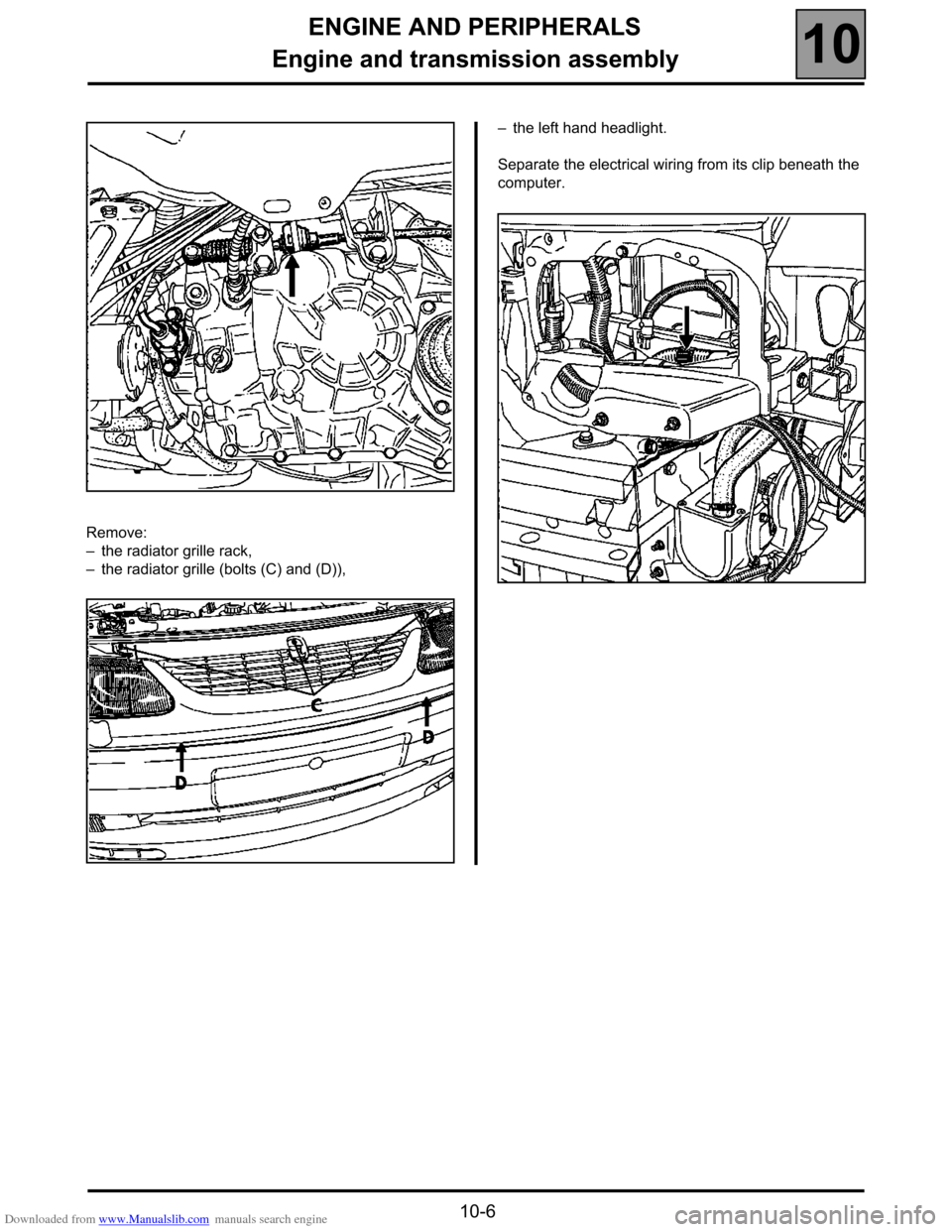
Downloaded from www.Manualslib.com manuals search engine ENGINE AND PERIPHERALS
Engine and transmission assembly
10
10-6
Remove:
–the radiator grille rack,
–the radiator grille (bolts (C) and (D)),–the left hand headlight.
Separate the electrical wiring from its clip beneath the
computer.
Page 11 of 52
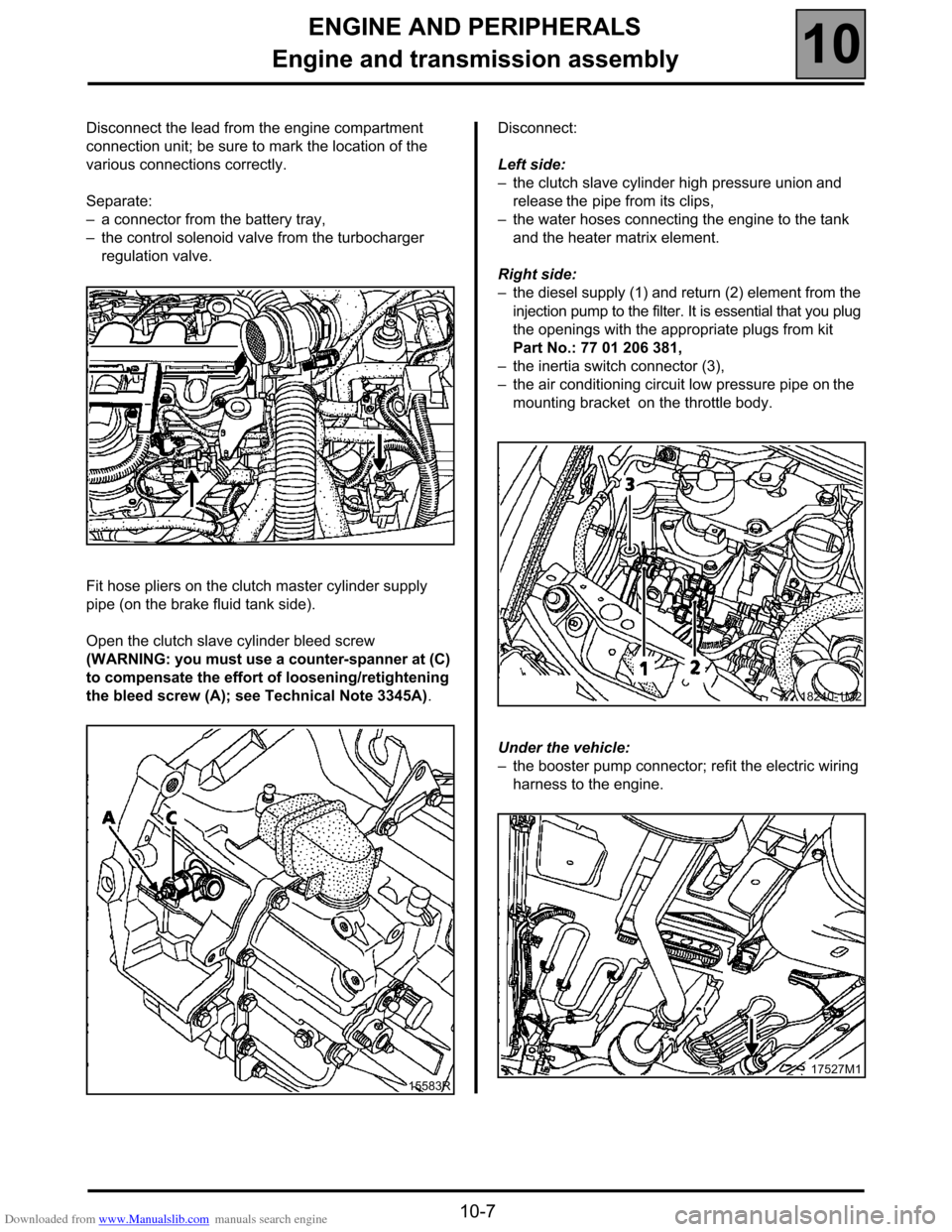
Downloaded from www.Manualslib.com manuals search engine ENGINE AND PERIPHERALS
Engine and transmission assembly
10
10-7
Disconnect the lead from the engine compartment
connection unit; be sure to mark the location of the
various connections correctly.
Separate:
–a connector from the battery tray,
–the control solenoid valve from the turbocharger
regulation valve.
Fit hose pliers on the clutch master cylinder supply
pipe (on the brake fluid tank side).
Open the clutch slave cylinder bleed screw
(WARNING: you must use a counter-spanner at (C)
to compensate the effort of loosening/retightening
the bleed screw (A); see Technical Note 3345A).Disconnect:
Left side:
–the clutch slave cylinder high pressure union and
release the pipe from its clips,
–the water hoses connecting the engine to the tank
and the heater matrix element.
Right side:
–the diesel supply (1) and return (2) element from the
injection pump to the filter. It is essential that you plug
the openings with the appropriate plugs from kit
Part No.: 77 01 206 381,
–the inertia switch connector (3),
–the air conditioning circuit low pressure pipe on the
mounting bracket on the throttle body.
Under the vehicle:
–the booster pump connector; refit the electric wiring
harness to the engine.
15583R
18240-1M2
17527M1
Page 27 of 52
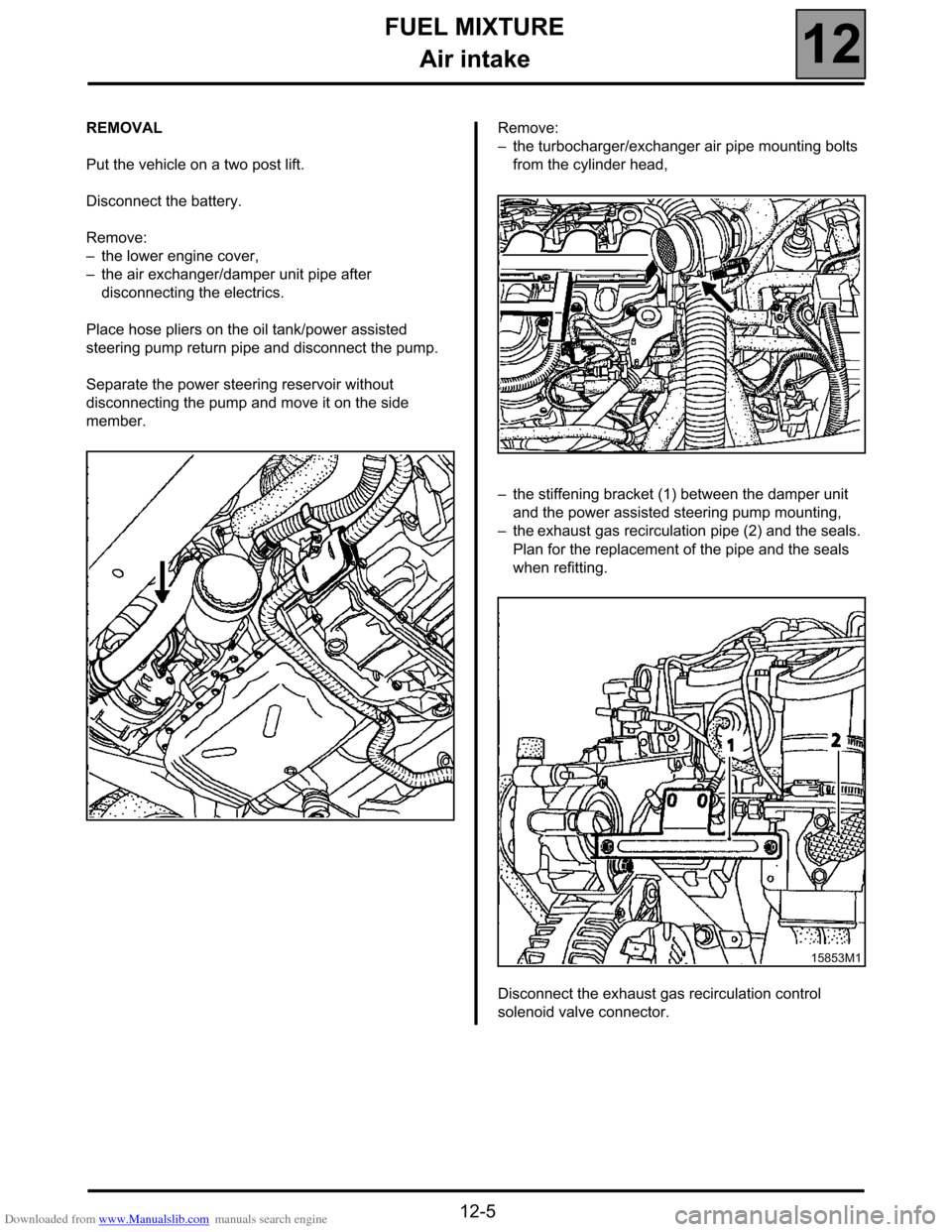
Downloaded from www.Manualslib.com manuals search engine FUEL MIXTURE
Air intake
12
12-5
REMOVAL
Put the vehicle on a two post lift.
Disconnect the battery.
Remove:
–the lower engine cover,
–the air exchanger/damper unit pipe after
disconnecting the electrics.
Place hose pliers on the oil tank/power assisted
steering pump return pipe and disconnect the pump.
Separate the power steering reservoir without
disconnecting the pump and move it on the side
member.Remove:
–the turbocharger/exchanger air pipe mounting bolts
from the cylinder head,
–the stiffening bracket (1) between the damper unit
and the power assisted steering pump mounting,
–the exhaust gas recirculation pipe (2) and the seals.
Plan for the replacement of the pipe and the seals
when refitting.
Disconnect the exhaust gas recirculation control
solenoid valve connector.
15853M1
Page 28 of 52
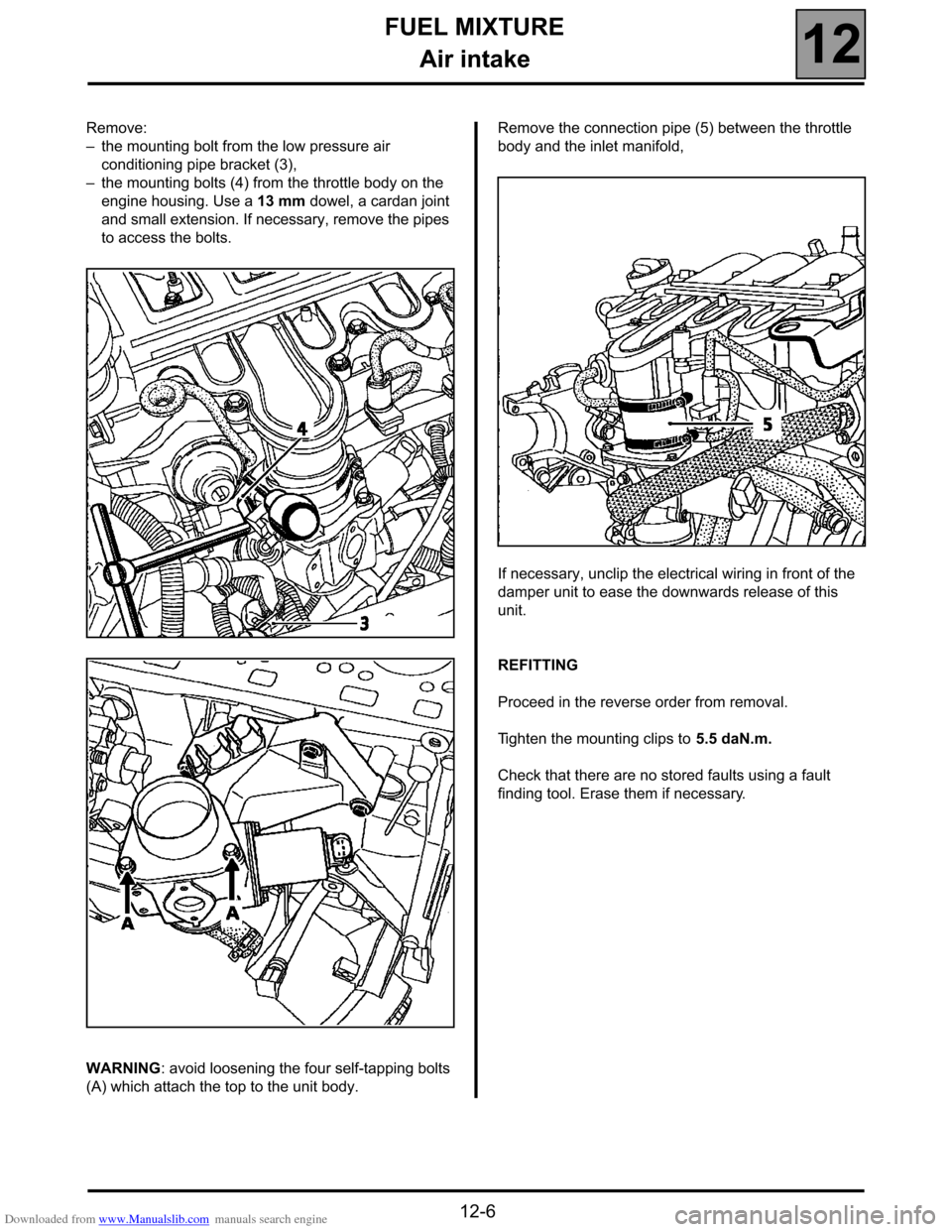
Downloaded from www.Manualslib.com manuals search engine FUEL MIXTURE
Air intake
12
12-6
Remove:
–the mounting bolt from the low pressure air
conditioning pipe bracket (3),
–the mounting bolts (4) from the throttle body on the
engine housing. Use a 13 mm dowel, a cardan joint
and small extension. If necessary, remove the pipes
to access the bolts.
WARNING: avoid loosening the four self-tapping bolts
(A) which attach the top to the unit body.Remove the connection pipe (5) between the throttle
body and the inlet manifold,
If necessary, unclip the electrical wiring in front of the
damper unit to ease the downwards release of this
unit.
REFITTING
Proceed in the reverse order from removal.
Tighten the mounting clips to 5.5 daN.m.
Check that there are no stored faults using a fault
finding tool. Erase them if necessary.
Page 33 of 52
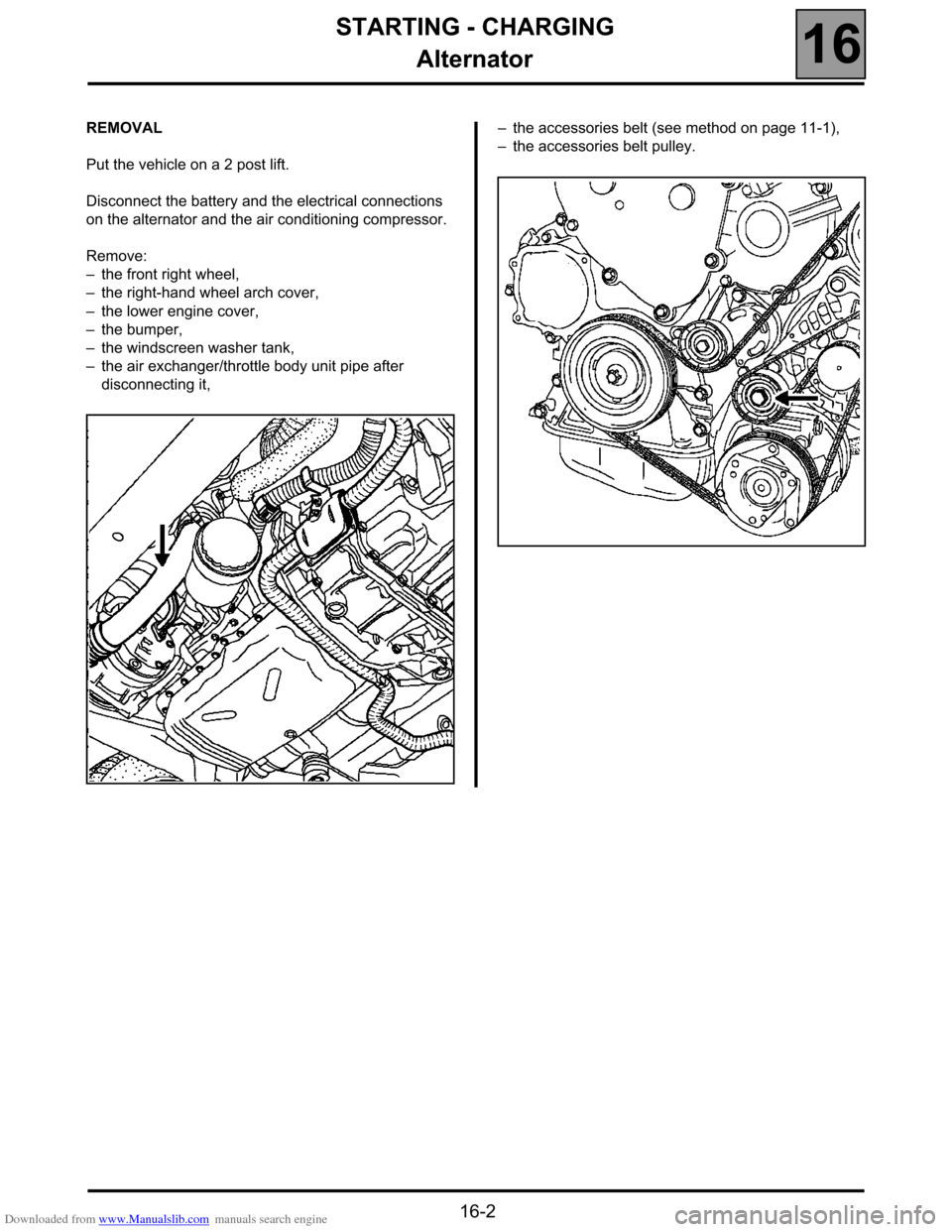
Downloaded from www.Manualslib.com manuals search engine STARTING - CHARGING
Alternator
16
16-2
REMOVAL
Put the vehicle on a 2 post lift.
Disconnect the battery and the electrical connections
on the alternator and the air conditioning compressor.
Remove:
–the front right wheel,
–the right-hand wheel arch cover,
–the lower engine cover,
–the bumper,
–the windscreen washer tank,
–the air exchanger/throttle body unit pipe after
disconnecting it,–the accessories belt (see method on page 11-1),
–the accessories belt pulley.
Page 36 of 52
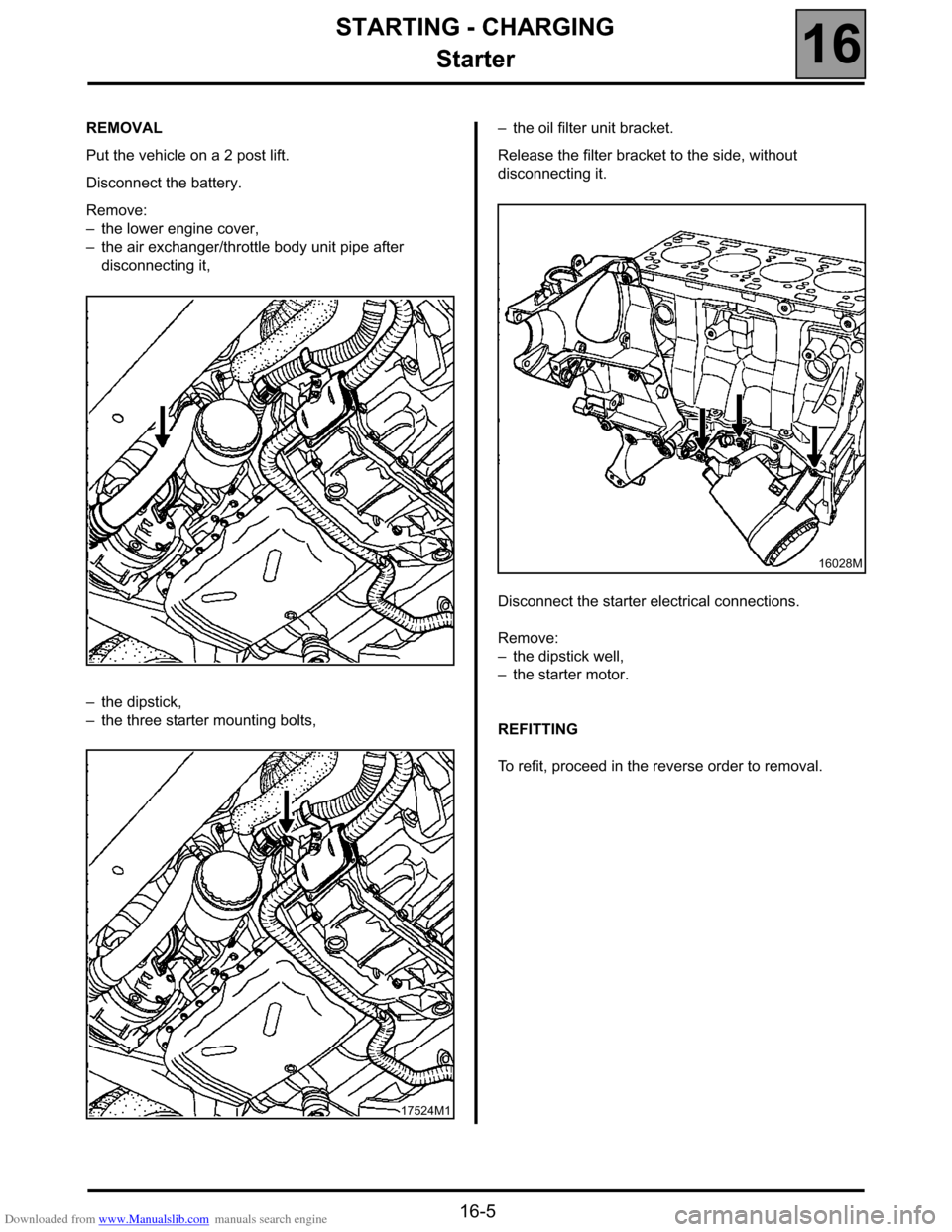
Downloaded from www.Manualslib.com manuals search engine STARTING - CHARGING
Starter
16
16-5
REMOVAL
Put the vehicle on a 2 post lift.
Disconnect the battery.
Remove:
–the lower engine cover,
–the air exchanger/throttle body unit pipe after
disconnecting it,
–the dipstick,
–the three starter mounting bolts,–the oil filter unit bracket.
Release the filter bracket to the side, without
disconnecting it.
Disconnect the starter electrical connections.
Remove:
–the dipstick well,
–the starter motor.
REFITTING
To refit, proceed in the reverse order to removal.
17524M1
16028M
Page 41 of 52
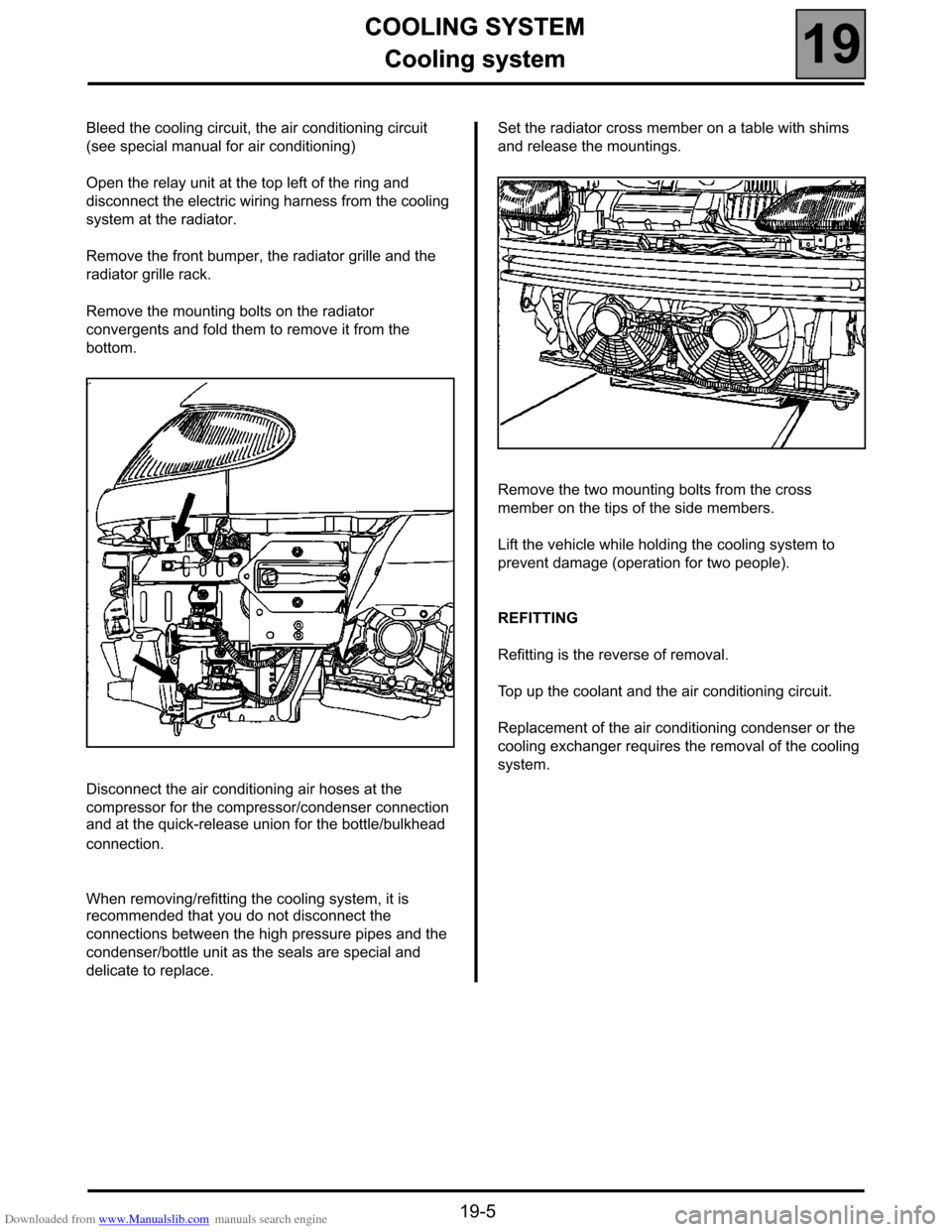
Downloaded from www.Manualslib.com manuals search engine COOLING SYSTEM
Cooling system
19
19-5
COOLING SYSTEM
Cooling system
Bleed the cooling circuit, the air conditioning circuit
(see special manual for air conditioning)
Open the relay unit at the top left of the ring and
disconnect the electric wiring harness from the cooling
system at the radiator.
Remove the front bumper, the radiator grille and the
radiator grille rack.
Remove the mounting bolts on the radiator
convergents and fold them to remove it from the
bottom.
Disconnect the air conditioning air hoses at the
compressor for the compressor/condenser connection
and at the quick-release union for the bottle/bulkhead
connection.
When removing/refitting the cooling system, it is
recommended that you do not disconnect the
connections between the high pressure pipes and the
condenser/bottle unit as the seals are special and
delicate to replace.Set the radiator cross member on a table with shims
and release the mountings.
Remove the two mounting bolts from the cross
member on the tips of the side members.
Lift the vehicle while holding the cooling system to
prevent damage (operation for two people).
REFITTING
Refitting is the reverse of removal.
Top up the coolant and the air conditioning circuit.
Replacement of the air conditioning condenser or the
cooling exchanger requires the removal of the cooling
system.
Page 47 of 52
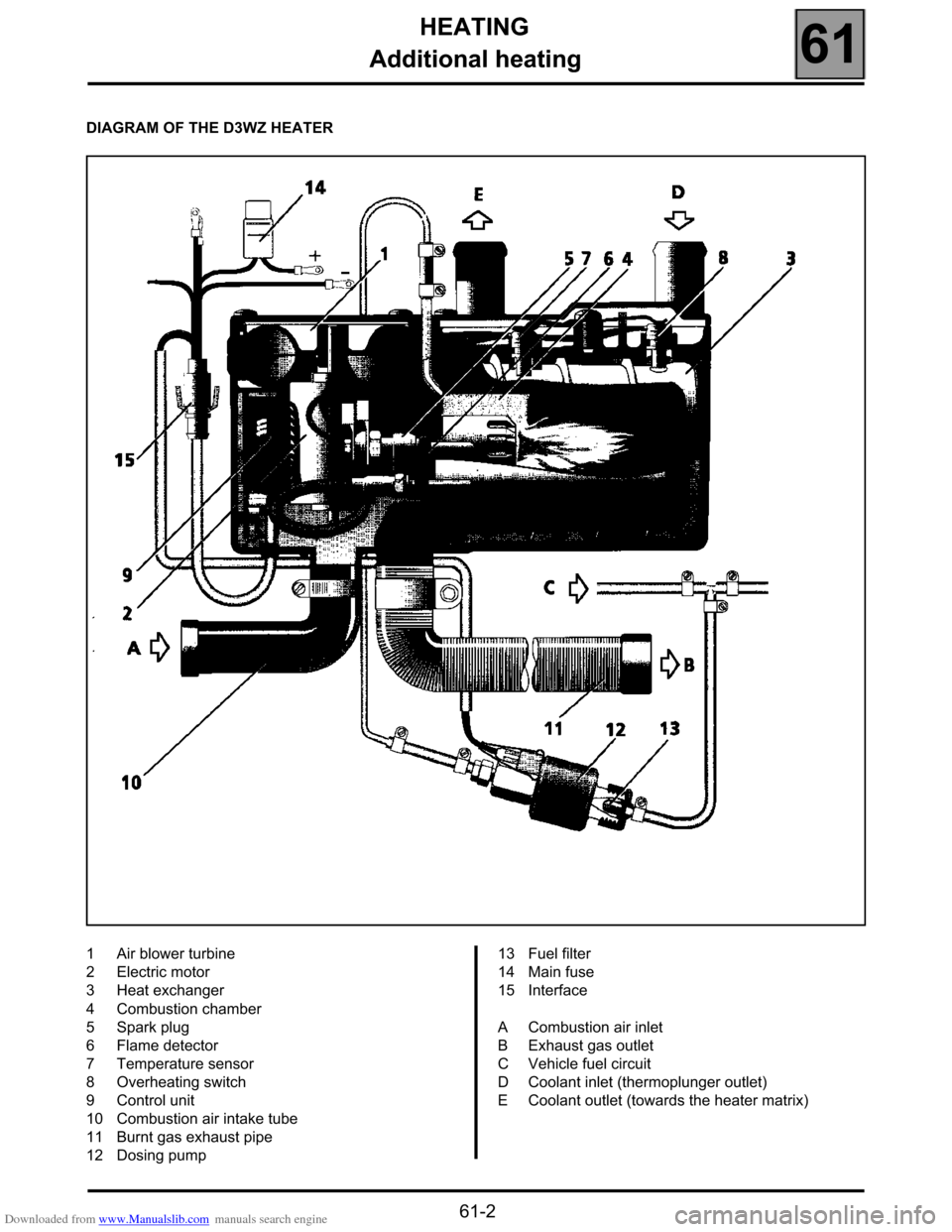
Downloaded from www.Manualslib.com manuals search engine HEATING
Additional heating
61
61-2
DIAGRAM OF THE D3WZ HEATER
1Air blower turbine
2Electric motor
3Heat exchanger
4Combustion chamber
5Spark plug
6Flame detector
7Temperature sensor
8Overheating switch
9Control unit
10 Combustion air intake tube
11 Burnt gas exhaust pipe
12 Dosing pump 13 Fuel filter
14 Main fuse
15 Interface
ACombustion air inlet
BExhaust gas outlet
CVehicle fuel circuit
DCoolant inlet (thermoplunger outlet)
ECoolant outlet (towards the heater matrix)
Page 51 of 52
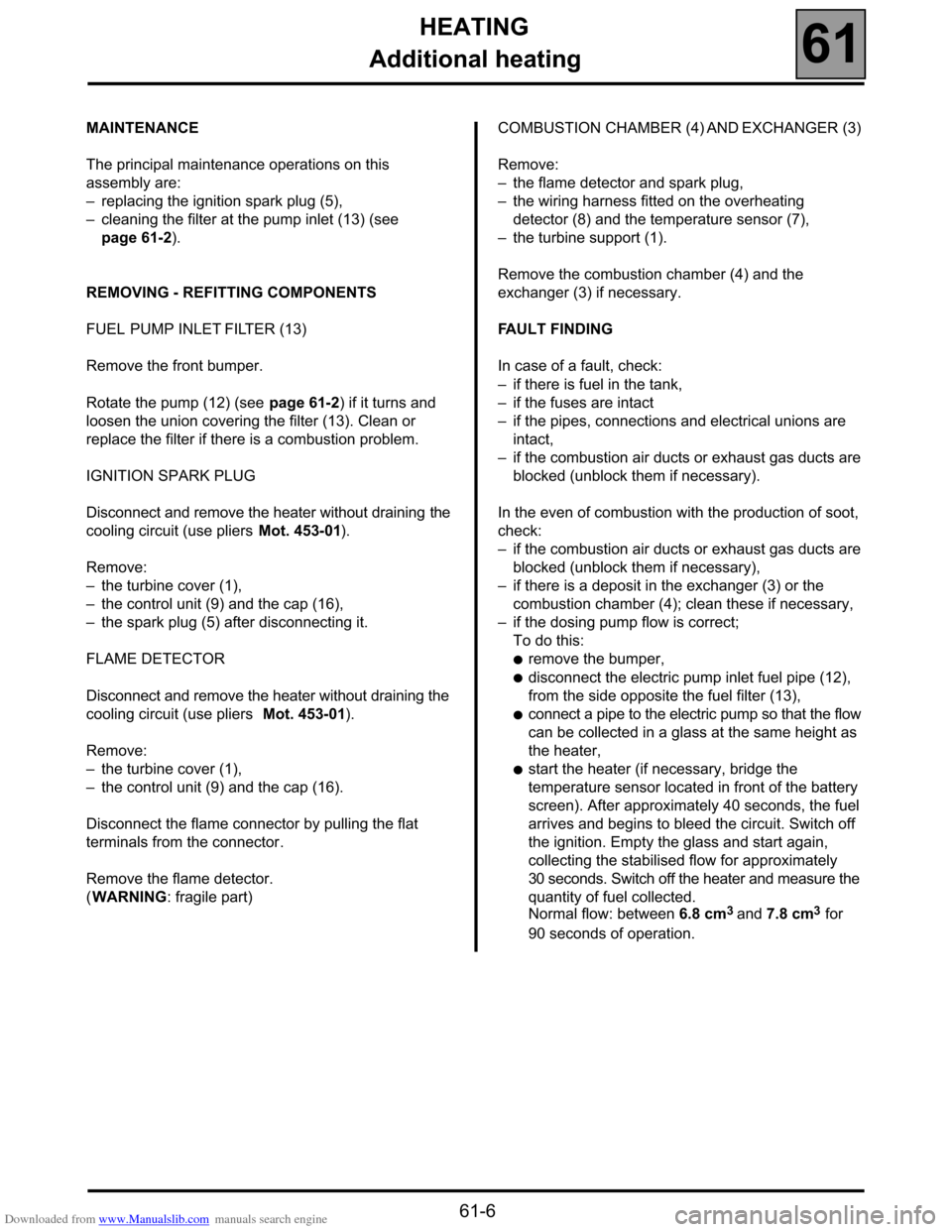
Downloaded from www.Manualslib.com manuals search engine HEATING
Additional heating
61
61-6
MAINTENANCE
The principal maintenance operations on this
assembly are:
–replacing the ignition spark plug (5),
–cleaning the filter at the pump inlet (13) (see
page 61-2).
REMOVING - REFITTING COMPONENTS
FUEL PUMP INLET FILTER (13)
Remove the front bumper.
Rotate the pump (12) (see page 61-2) if it turns and
loosen the union covering the filter (13). Clean or
replace the filter if there is a combustion problem.
IGNITION SPARK PLUG
Disconnect and remove the heater without draining the
cooling circuit (use pliers Mot. 453-01).
Remove:
–the turbine cover (1),
–the control unit (9) and the cap (16),
–the spark plug (5) after disconnecting it.
FLAME DETECTOR
Disconnect and remove the heater without draining the
cooling circuit (use pliers Mot. 453-01).
Remove:
–the turbine cover (1),
–the control unit (9) and the cap (16).
Disconnect the flame connector by pulling the flat
terminals from the connector.
Remove the flame detector.
(WARNING: fragile part)COMBUSTION CHAMBER (4) AND EXCHANGER (3)
Remove:
–the flame detector and spark plug,
–the wiring harness fitted on the overheating
detector (8) and the temperature sensor (7),
–the turbine support (1).
Remove the combustion chamber (4) and the
exchanger (3) if necessary.
FAULT FINDING
In case of a fault, check:
–if there is fuel in the tank,
–if the fuses are intact
–if the pipes, connections and electrical unions are
intact,
–if the combustion air ducts or exhaust gas ducts are
blocked (unblock them if necessary).
In the even of combustion with the production of soot,
check:
–if the combustion air ducts or exhaust gas ducts are
blocked (unblock them if necessary),
–if there is a deposit in the exchanger (3) or the
combustion chamber (4); clean these if necessary,
–if the dosing pump flow is correct;
To do this:
â—Źremove the bumper,
â—Źdisconnect the electric pump inlet fuel pipe (12),
from the side opposite the fuel filter (13),
â—Źconnect a pipe to the electric pump so that the flow
can be collected in a glass at the same height as
the heater,
â—Źstart the heater (if necessary, bridge the
temperature sensor located in front of the battery
screen). After approximately 40 seconds, the fuel
arrives and begins to bleed the circuit. Switch off
the ignition. Empty the glass and start again,
collecting the stabilised flow for approximately
30 seconds. Switch off the heater and measure the
quantity of fuel collected.
Normal flow: between 6.8 cm
3 and 7.8 cm3 for
90 seconds of operation.